11.6E: Ejercicios
- Page ID
- 112784
La práctica hace la perfección
En los siguientes ejercicios, resuelve el sistema de ecuaciones mediante la gráfica.
- \(\left\{\begin{array}{l}{y=2 x+2} \\ {y=-x^{2}+2}\end{array}\right.\)
- \(\left\{\begin{array}{l}{y=6 x-4} \\ {y=2 x^{2}}\end{array}\right.\)
- \(\left\{\begin{array}{l}{x+y=2} \\ {x=y^{2}}\end{array}\right.\)
- \(\left\{\begin{array}{l}{x-y=-2} \\ {x=y^{2}}\end{array}\right.\)
- \(\left\{\begin{array}{l}{y=\frac{3}{2} x+3} \\ {y=-x^{2}+2}\end{array}\right.\)
- \(\left\{\begin{array}{l}{y=x-1} \\ {y=x^{2}+1}\end{array}\right.\)
- \(\left\{\begin{array}{l}{x=-2} \\ {x^{2}+y^{2}=4}\end{array}\right.\)
- \(\left\{\begin{array}{l}{y=-4} \\ {x^{2}+y^{2}=16}\end{array}\right.\)
- \(\left\{\begin{array}{l}{x=2} \\ {(x+2)^{2}+(y+3)^{2}=16}\end{array}\right.\)
- \(\left\{\begin{array}{l}{y=-1} \\ {(x-2)^{2}+(y-4)^{2}=25}\end{array}\right.\)
- \(\left\{\begin{array}{l}{y=-2 x+4} \\ {y=\sqrt{x}+1}\end{array}\right.\)
- \(\left\{\begin{array}{l}{y=-\frac{1}{2} x+2} \\ {y=\sqrt{x}-2}\end{array}\right.\)
- Responder
-
2.
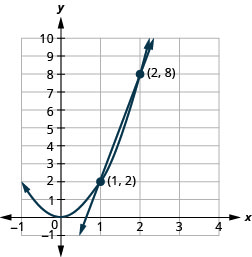
Figura 11.5.61 4.
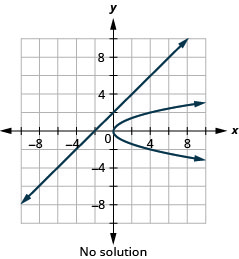
Figura 11.5.62 6.

Figura 11.5.63 8.
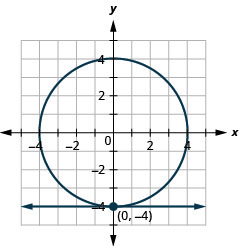
Figura 11.5.64 10.
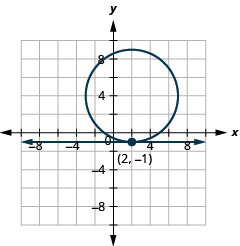
Figura 11.5.65 12.
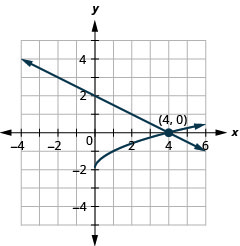
Figura 11.5.66
En los siguientes ejercicios, resolver el sistema de ecuaciones mediante la sustitución.
- \(\left\{\begin{array}{l}{x^{2}+4 y^{2}=4} \\ {y=\frac{1}{2} x-1}\end{array}\right.\)
- \(\left\{\begin{array}{l}{9 x^{2}+y^{2}=9} \\ {y=3 x+3}\end{array}\right.\)
- \(\left\{\begin{array}{l}{9 x^{2}+y^{2}=9} \\ {y=x+3}\end{array}\right.\)
- \(\left\{\begin{array}{l}{9 x^{2}+4 y^{2}=36} \\ {x=2}\end{array}\right.\)
- \(\left\{\begin{array}{l}{4 x^{2}+y^{2}=4} \\ {y=4}\end{array}\right.\)
- \(\left\{\begin{array}{l}{x^{2}+y^{2}=169} \\ {x=12}\end{array}\right.\)
- \(\left\{\begin{array}{l}{3 x^{2}-y=0} \\ {y=2 x-1}\end{array}\right.\)
- \(\left\{\begin{array}{l}{2 y^{2}-x=0} \\ {y=x+1}\end{array}\right.\)
- \(\left\{\begin{array}{l}{y=x^{2}+3} \\ {y=x+3}\end{array}\right.\)
- \(\left\{\begin{array}{l}{y=x^{2}-4} \\ {y=x-4}\end{array}\right.\)
- \(\left\{\begin{array}{l}{x^{2}+y^{2}=25} \\ {x-y=1}\end{array}\right.\)
- \(\left\{\begin{array}{l}{x^{2}+y^{2}=25} \\ {2 x+y=10}\end{array}\right.\)
- Responder
-
2. \((-1,0),(0,3)\)
4. \((2,0)\)
6. \((12,-5),(12,5)\)
8. Sin solución
10. \((0,-4),(1,-3)\)
12. \((3,4),(5,0)\)
En los siguientes ejercicios, resuelve el sistema de ecuaciones mediante el uso de la eliminación.
- \(\left\{\begin{array}{l}{x^{2}+y^{2}=16} \\ {x^{2}-2 y=8}\end{array}\right.\)
- \(\left\{\begin{array}{l}{x^{2}+y^{2}=16} \\ {x^{2}-y=4}\end{array}\right.\)
- \(\left\{\begin{array}{l}{x^{2}+y^{2}=4} \\ {x^{2}+2 y=1}\end{array}\right.\)
- \(\left\{\begin{array}{l}{x^{2}+y^{2}=4} \\ {x^{2}-y=2}\end{array}\right.\)
- \(\left\{\begin{array}{l}{x^{2}+y^{2}=9} \\ {x^{2}-y=3}\end{array}\right.\)
- \(\left\{\begin{array}{l}{x^{2}+y^{2}=4} \\ {y^{2}-x=2}\end{array}\right.\)
- \(\left\{\begin{array}{l}{x^{2}+y^{2}=25} \\ {2 x^{2}-3 y^{2}=5}\end{array}\right.\)
- \(\left\{\begin{array}{l}{x^{2}+y^{2}=20} \\ {x^{2}-y^{2}=-12}\end{array}\right.\)
- \(\left\{\begin{array}{l}{x^{2}+y^{2}=13} \\ {x^{2}-y^{2}=5}\end{array}\right.\)
- \(\left\{\begin{array}{l}{x^{2}+y^{2}=16} \\ {x^{2}-y^{2}=16}\end{array}\right.\)
- \(\left\{\begin{array}{l}{4 x^{2}+9 y^{2}=36} \\ {2 x^{2}-9 y^{2}=18}\end{array}\right.\)
- \(\left\{\begin{array}{l}{x^{2}-y^{2}=3} \\ {2 x^{2}+y^{2}=6}\end{array}\right.\)
- \(\left\{\begin{array}{l}{4 x^{2}-y^{2}=4} \\ {4 x^{2}+y^{2}=4}\end{array}\right.\)
- \(\left\{\begin{array}{l}{x^{2}-y^{2}=-5} \\ {3 x^{2}+2 y^{2}=30}\end{array}\right.\)
- \(\left\{\begin{array}{l}{x^{2}-y^{2}=1} \\ {x^{2}-2 y=4}\end{array}\right.\)
- \(\left\{\begin{array}{l}{2 x^{2}+y^{2}=11} \\ {x^{2}+3 y^{2}=28}\end{array}\right.\)
- Responder
-
2. \((0,-4),(-\sqrt{7}, 3),(\sqrt{7}, 3)\)
4. \((0,-2),(-\sqrt{3}, 1),(\sqrt{3}, 1)\)
6. \((-2,0),(1,-\sqrt{3}),(1, \sqrt{3})\)
8. \((-2,-4),(-2,4),(2,-4),(2,4)\)
10. \((-4,0),(4,0)\)
12. \((-\sqrt{3}, 0),(\sqrt{3}, 0)\)
14. \((-2,-3),(-2,3),(2,-3),(2,3)\)
16. \((-1,-3),(-1,3),(1,-3),(1,3)\)
En los siguientes ejercicios, resolver el problema utilizando un sistema de ecuaciones.
- La suma de dos números es\(−6\) y el producto es\(8\). Encuentra los números.
- La suma de dos números es\(11\) y el producto es\(−42\). Encuentra los números.
- La suma de los cuadrados de dos números es\(65\). La diferencia del número es\(3\). Encuentra los números.
- La suma de los cuadrados de dos números es\(113\). La diferencia del número es\(1\). Encuentra los números.
- La diferencia de los cuadrados de dos números es\(15\). La diferencia de dos veces el cuadrado del primer número y el cuadrado del segundo número es\(30\). Encuentra los números.
- La diferencia de los cuadrados de dos números es\(20\). La diferencia del cuadrado del primer número y dos veces el cuadrado del segundo número es\(4\). Encuentra los números.
- El perímetro de un rectángulo es de\(32\) pulgadas y su área es de pulgadas\(63\) cuadradas. Encuentra el largo y ancho del rectángulo.
- El perímetro de un rectángulo es\(52\) cm y su área es\(165\)\(\mathrm{cm}^{2}\). Encuentra el largo y ancho del rectángulo.
- Dion compró un nuevo microondas. La diagonal de la puerta mide\(17\) pulgadas. La puerta también tiene un área de pulgadas\(120\) cuadradas. ¿Cuál es el largo y ancho de la puerta del microondas?
- Jules compró un microondas para su cocina. La diagonal del frente del microondas mide\(26\) pulgadas. El frente también tiene un área de pulgadas\(240\) cuadradas. ¿Cuál es el largo y ancho del microondas?
- Roman encontró a la venta un televisor de pantalla ancha, pero no está seguro de si encajará en su centro de entretenimiento. El televisor es\(60\)”. El tamaño de un televisor se mide en la diagonal de la pantalla y una pantalla ancha tiene una longitud que es mayor que el ancho. La pantalla también tiene un área de pulgadas\(1728\) cuadradas. Su centro de entretenimiento tiene un inserto para el televisor con un largo de\(50\) pulgadas y ancho de\(40\) pulgadas. ¿Cuál es el largo y ancho de la pantalla del televisor y encajará en el centro de entretenimiento de Roman?
- Donnette encontró un televisor de pantalla ancha en una venta de garaje, pero no está seguro de si se ajustará a su centro de entretenimiento. El televisor es\(50\)”. El tamaño de un televisor se mide en la diagonal de la pantalla y una pantalla ancha tiene una longitud que es mayor que el ancho. La pantalla también tiene un área de pulgadas\(1200\) cuadradas. Su centro de entretenimiento tiene un inserto para el televisor con un largo de\(38\) pulgadas y ancho de\(27\) pulgadas. ¿Cuál es el largo y ancho de la pantalla del televisor y encajará en el centro de entretenimiento de Donnette?
- Responder
-
2. \(-3\)y\(14\)
4. \(-7\)y\(-8\) o\(8\) y\(7\)
6. \(-6\)y\(-4\) o\(-6\) y\(4\) o\(6\) y\(-4\) o\(6\) y\(4\)
8. Si el largo es\(11\) cm, el ancho es\(15\) cm. Si el largo es\(15\) cm, el ancho es\(11\) cm.
10. Si el largo es\(10\) pulgadas, el ancho es\(24\) pulgadas. Si el largo es\(24\) pulgadas, el ancho es\(10\) pulgadas.
12. El largo es\(40\) pulgadas y el ancho es\(30\) pulgadas. El televisor no encajará en el centro de entretenimiento de Donnette.
- En sus propias palabras, explique las ventajas y desventajas de resolver un sistema de ecuaciones mediante la gráfica.
- Explica con tus propias palabras cómo resolver un sistema de ecuaciones usando la sustitución.
- Explica con tus propias palabras cómo resolver un sistema de ecuaciones usando la eliminación.
- Un círculo y una parábola pueden cruzarse de maneras que resultarían en\(0, 1, 2, 3,\)\(4\) soluciones. Dibuja un boceto de cada una de las posibilidades.
- Responder
-
2. Las respuestas pueden variar
4. Las respuestas pueden variar
Autocomprobación
a. después de completar los ejercicios, utilice esta lista de verificación para evaluar su dominio de los objetivos de esta sección.
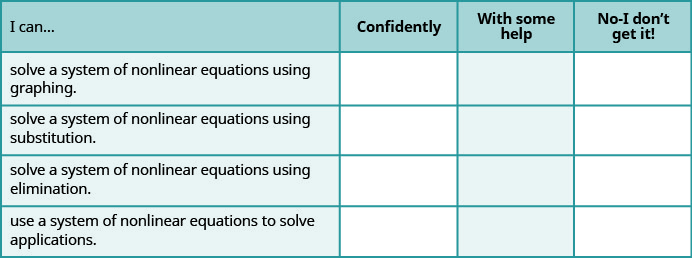
b. después de mirar la lista de verificación, ¿cree que está bien preparado para la siguiente sección? ¿Por qué o por qué no?


